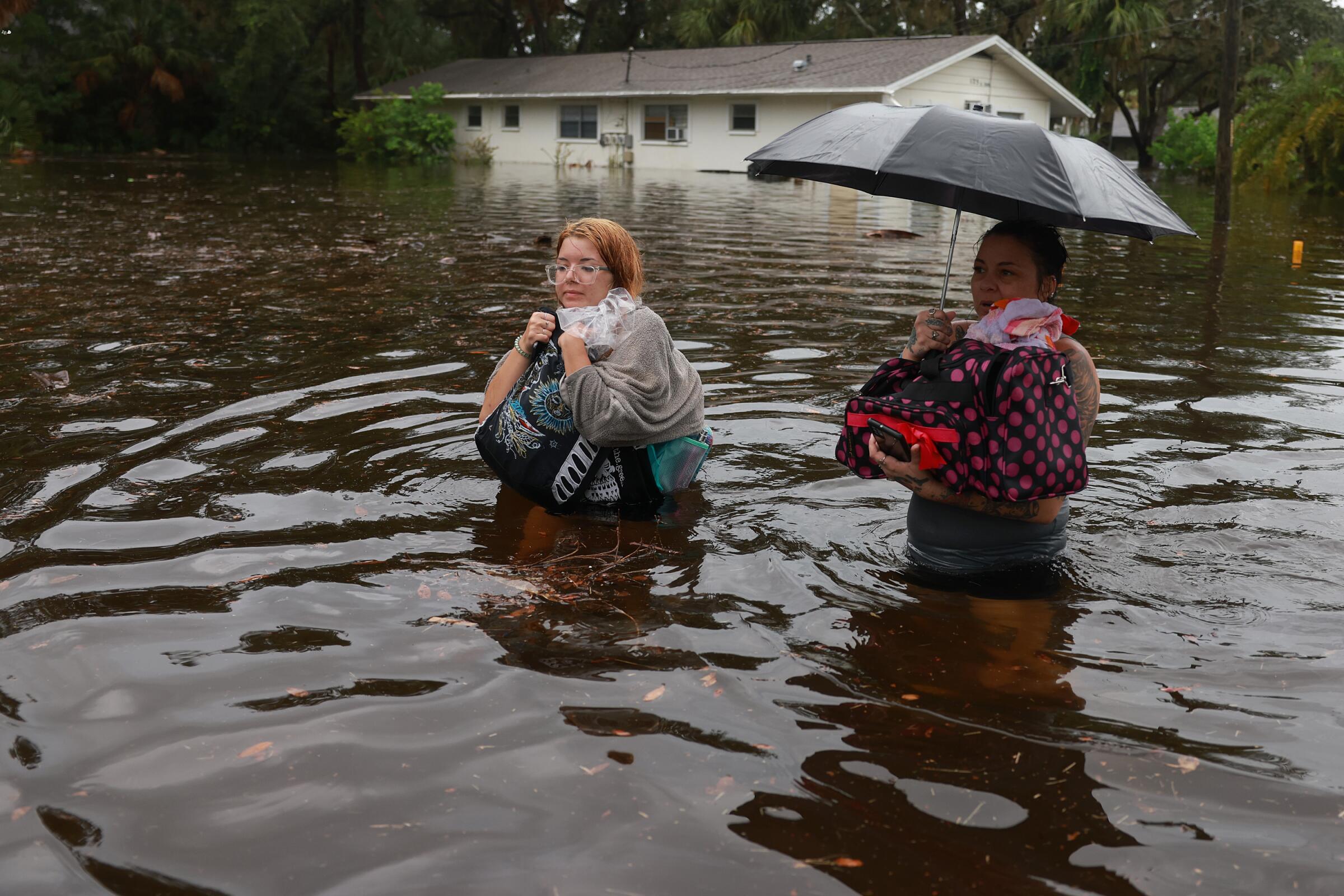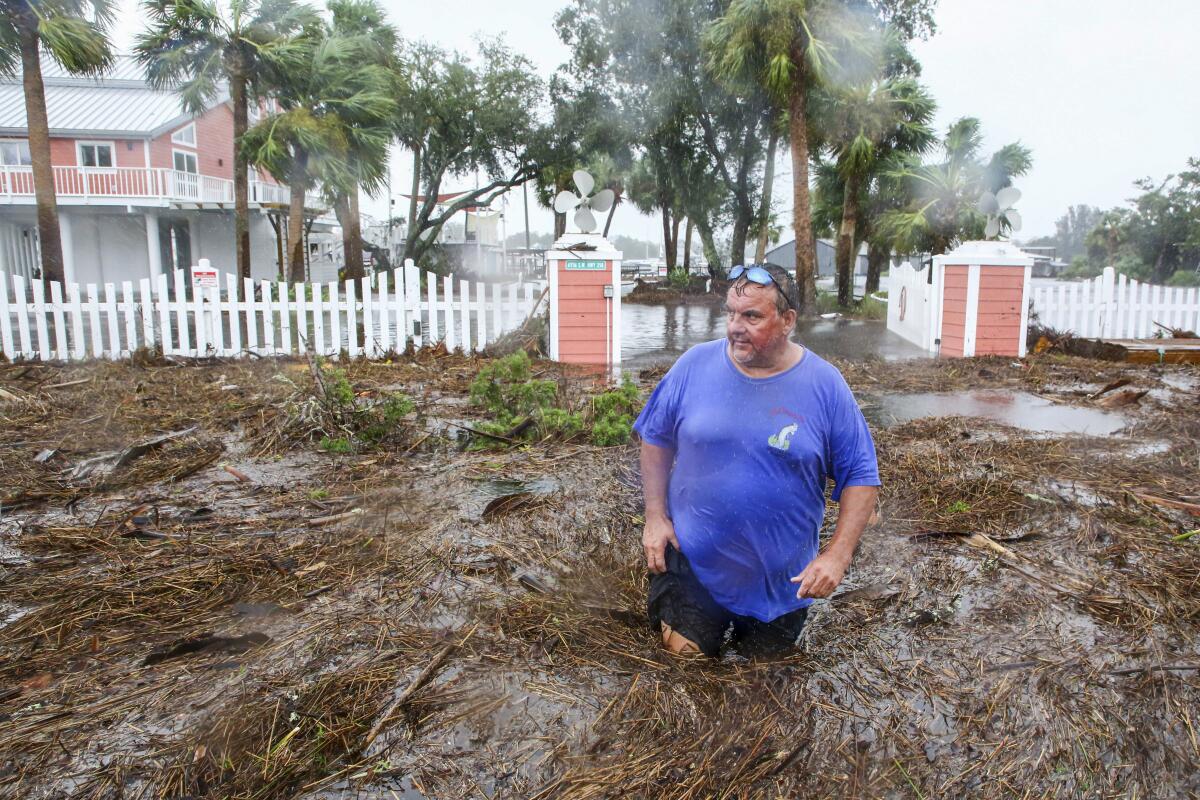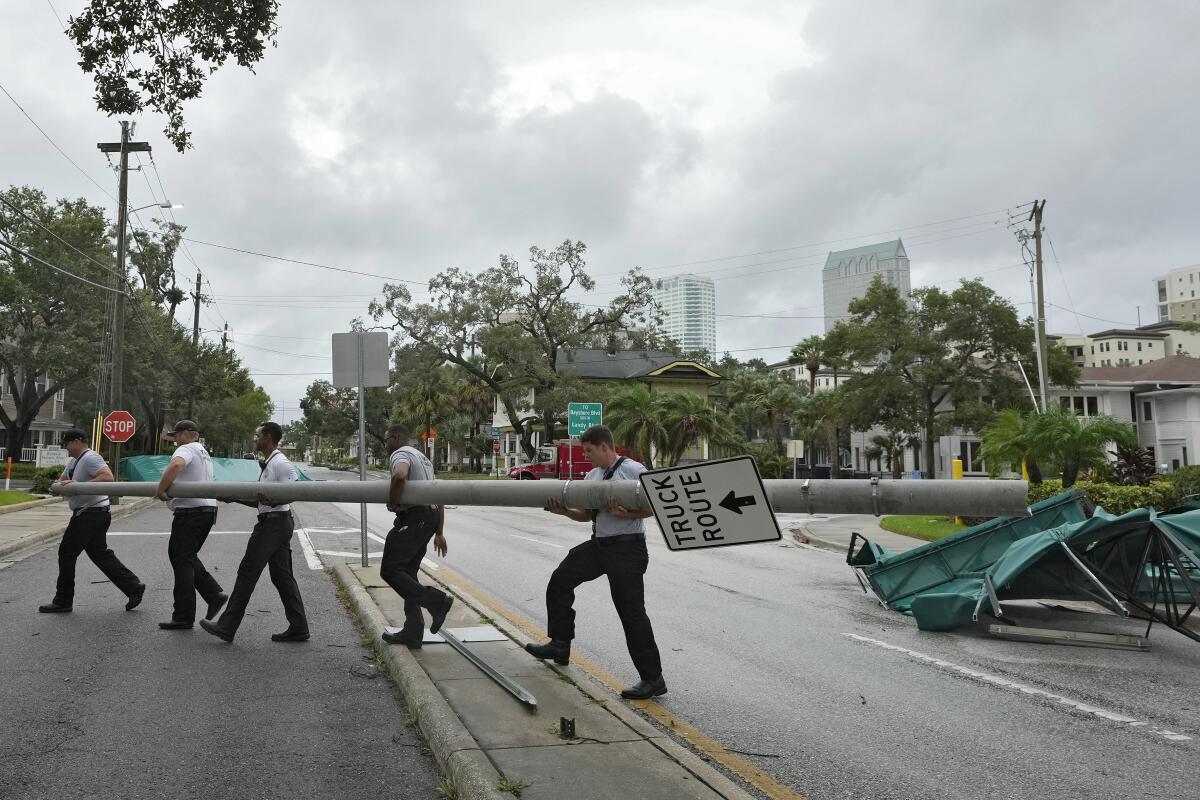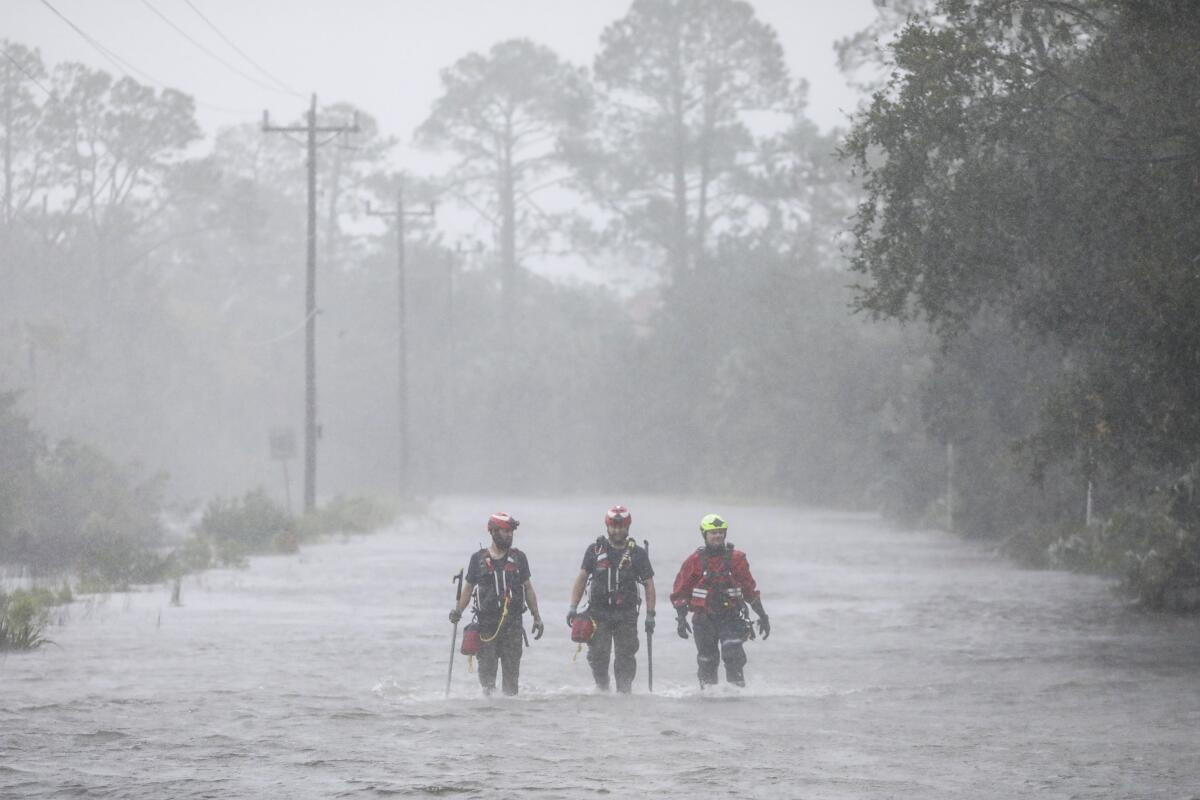Newsletter
Sign up for Essential California
The most important California stories and recommendations in your inbox every morning.
You may occasionally receive promotional content from the Los Angeles Times.

CEDAR KEY, Fla. — Hurricane Idalia tore into Florida with winds howling at the speed of a fast-moving train Wednesday, splitting trees in half, ripping roofs off hotels and turning small cars into boats before sweeping into Georgia as a still-powerful storm that flooded roadways and sent residents running for higher ground.
“All hell broke loose,” said Belond Thomas of Perry, a mill town located just inland from the Big Bend region where Idalia came ashore.
Thomas fled with her family and some friends to a motel, thinking it would be safer than riding out the storm at home. But as Idalia’s eye passed over about 8:30 a.m., a loud whistling noise pierced the air and the high winds ripped the building’s roof off, sending debris down on her pregnant daughter, who was lying in bed. Fortunately, she was not injured.
“It was frightening,” Thomas said. “Things were just going so fast. ... Everything was spinning.”
After coming ashore, Idalia made landfall near Keaton Beach at 7:45 a.m. as a high-end Category 3 hurricane with maximum sustained winds near 125 mph. It had weakened to a tropical storm with winds of 70 mph by Wednesday afternoon.
Hurricane Idalia hit Florida as a Category 3 storm, submerging homes and vehicles, turning streets into rivers and downing power lines before sweeping into Georgia.
As the eye moved inland, high winds shredded signs, blew off roofs, sent sheet metal flying and snapped tall trees. But as of midday Wednesday, there were no confirmed deaths in Florida, although fatal traffic accidents in two counties may end up being storm-related, Florida Gov. Ron DeSantis said.
Unlike last year’s Hurricane Ian, which hit the heavily populated Fort Myers area, leaving 149 dead in the state, Idalia blew into a very lightly populated area known as Florida’s “nature coast,” one of the state’s most rural regions that lies far from crowded metropolises or busy tourist areas and features millions of acres of undeveloped land.
That doesn’t mean that it didn’t do major damage. Rushing water covered streets near the coast, unmoored small boats and nearly a half-million customers in Florida and Georgia lost power. In Perry, the winds blew out store windows, tore siding off buildings and overturned a gas station canopy. Heavy rains partially flooded Interstate 275 in Tampa and toppled power lines onto the northbound side of Interstate 75 just south of Valdosta, Ga.

The storm surge could rise as high as 16 feet in some places. Some counties implemented curfews to keep residents off roads.
Less than 20 miles south of where Idalia made landfall, businesses, boat docks and homes in Steinhatchee, Fla., were swallowed up by water surging in from Deadman Bay. Police officers blocked traffic into the coastal community of more than 500 residents known for its fishing and foresting industries.
State officials, 5,500 National Guardsmen and rescue crews were in search-and-recovery mode, inspecting bridges, clearing toppled trees and looking for anyone in distress.
Should Cape Coral and other low-lying cities in Florida rebuild in an era of more intense hurricanes, higher rainfall and rising seas?
Because of the remoteness of the Big Bend area, search teams may need more time to complete their work compared with past hurricanes in more urban areas, said Kevin Guthrie, director of the Florida Division of Emergency Management.
“You may have two houses on a five-mile road, so it’s going to take some time,” Guthrie said.
The National Weather Service in Tallahassee called Idalia “an unprecedented event” since no major hurricanes on record have ever passed through the bay abutting the Big Bend.
On the island of Cedar Key, downed trees and debris blocked roads, and propane tanks exploded.
RJ Wright stayed behind on Cedar Key so he could check on elderly neighbors. He hunkered down with friends in a motel, and when it was safe, walked outside into chest-high water. It could have been a lot worse for the island, which juts into the Gulf of Mexico, since it didn’t take a direct hit, he said.
Wildfires in Canada and Hawaii. Hurricane Hilary set to strike California. Scientists have warned about worse storms and more frequent fires for years.
“It got pretty gnarly for a while, but it was nothing compared to some of the other storms,” Wright said.
The system remained a hurricane as it crossed into Georgia, with top winds of 90 mph, after drenching Florida mostly east of Tallahassee. Forecasters said it would punish the Carolinas overnight as a tropical storm.

In Tallahassee, Fla., the power went out well before the center of the storm arrived, but the city avoided a direct hit. A giant oak tree next to the governor’s mansion split in half, covering the yard with debris.
In Valdosta, Ga., Idalia’s fierce winds uprooted trees and sent rain flying sideways. Jonathon Wick said he didn’t take the approaching hurricane seriously until Wednesday morning when he awoke to howling winds outside his home. After plucking his young nephews from a trampoline in their backyard where water rose to his knees, he brought them to his car and was climbing into the driver’s seat when a tree toppled right in front of the vehicle.
It was just after 1 p.m. when Talia Butcher peered out the front door of her double-wide trailer a few blocks from the beach and saw the water creep up the banks of the canal behind her home and into her yard.
“If that tree would have fell on the car, I would be dead,” said Wick, who ended up getting rescued by another family member.
One man was killed in Valdosta when a tree fell on him as he was trying to clear another tree out of the road Wednesday, said Lowndes County Sheriff Ashley Paulk. Two others, including a sheriff’s deputy, were injured when the tree fell, Paulk said.
Idalia grew into a Category 2 system Tuesday afternoon and became a Category 3 for just hours Wednesday before peaking as a Category 4 hurricane.
At 5 p.m. Eastern time Wednesday, Tropical Storm Idalia was about 40 miles west of Savannah, Ga., and 115 miles west-southwest of Charleston, S.C., the National Hurricane Center said. It was moving northeast at 21 mph.

More than 30,000 utility workers in Florida were gathering to make repairs as quickly as possible in the hurricane’s wake. Airports in the region, including Tampa International Airport, planned to restart commercial operations Wednesday afternoon or Thursday. By midday Wednesday, more than 900 flights had been canceled in Florida and Georgia, according to tracking service FlightAware.
Start your day right
Sign up for Essential California for the L.A. Times biggest news, features and recommendations in your inbox six days a week.
You may occasionally receive promotional content from the Los Angeles Times.
Officials in Bermuda warned that Idalia could hit the island early next week as a tropical storm. Bermuda on Wednesday was being lashed by the outer bands of Hurricane Franklin, a Category 2 storm that was on track to pass near the island in the North Atlantic.
President Biden called the governors of Florida, Georgia, North Carolina and South Carolina on Wednesday and told them their states had his administration’s full support, the White House said.
Sign up for Essential California
The most important California stories and recommendations in your inbox every morning.
You may occasionally receive promotional content from the Los Angeles Times.